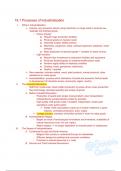18.1 Processes of Industrialization
I. What is Industrialization
➢ Industry: any economic activity using machinery on large scale to process raw
materials into finished goods
○ Heavy industry
■ Require huge production facilities
■ Produce goods on massive scale
■ Generally employ skilled workers
■ Machinery, equipment, ships, railroad equipment, airplanes, motor
vehicles
■ Mass production of identical goods + compete on basis of price
○ Light industry
■ Require less investment in production facilities and equipment
■ Produces finished goods on massive/small/custom scale
■ Workers highly skilled or relatively unskilled
■ Clothing, foods, gemstones, electronics
■ Quality > quantity
➢ Raw materials: includes metals, wood, plant products, animal products, other
substances to make goods
➢ Industrialization: process which interaction of social and economic factors leads
to development of industries across community, region, country
II. The Industrial Revolution
- Shift from small-scale, hand-crafted production to power-driven mass production
- New technology increased quantity and variety of goods
A. Before Industrial Revolution
- Production of goods took longer (manual labor); slow transportation
(transported by people/vehicles pulled by animals)
- High quality craft goods made in isolated, independent, small-scale
operations under guild system
➢ Guilds: trade associations made up of master craftsmen in given
industry; controlled production, price, output
➢ Cottage industry: members of families worked in home to make goods
B. Industrialization Begins
- Began as result of technological innovations and inventions; availability of
natural resources (coal, iron ore, water)
- Steam engines -> no longer dependent on muscle power or waterpower
III. The Spread of Industrialization
A. Continental Europe and North America
- Belgium first country in continental Europe to industrialize
- Diffusion delayed by political and economic conditions
- Proximity to natural resources (i.e. coal)
B. Second and Third Industrial Revolutions
, - Both built on system of interrelated technologies
- Second: powered by electricity and internal combustion engine
- Steel, automobile, airplane, chemical, consumer appliances
- Third: possible by advances in computerization and miniaturization
- After WWII
- Computer size, handheld devices
C. Colonialism and Imperialism
- Wealth from slave trade and sugar trade helped provide capital for
industrial expansion
- Improvements in transportation, weaponry
IV. Industrial Diffusion and Populations
- Second Agricultural Rev. around time of beginning of Industrial Rev.
- Improvement in medicine and public health
- Life expectancy goes up; death rates decrease
- Growth of middle class b/c job growth and economic expansion
- Rising wages, better health, higher levels of education, comfortable lives
- Rise in crime, public health challenges due to water disposal
Case Study - The Fourth Industrial Revolution
Issue: How will humanity handle the changes to come of the Fourth Industrial Revolution?
- AI, AR, genome editing, robotics, nanotechnology, 3D printing
- Global revolution - communication and interconnectedness
- Distinct group of “haves” and “have-nots”
- Idea of sustainability - adopt methods of production that minimizes environmental harm
18.2 How Economies are Structured
I. Economic Sectors: collections of similar economic activities
- Primary
- Farming and agriculture (LDCs), mining, fishing, forestry
- Provide basis for other economic activities
- Secondary
- Assemble raw materials into useful products (manufacturing)
- Tertiary
- Moving, selling, trading products in primary and secondary sectors
- Service sector; provides services than finished goods
- Services to people in exchange for payment (e.g. retailing, banking, law,
education, government)
- Quaternary
- Knowledge-based sector, focusing on research and information creations and
transfer




